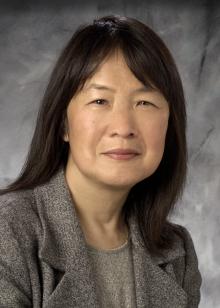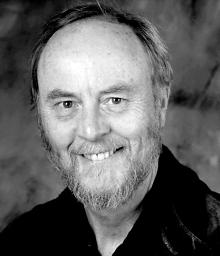

Two prominent UC Santa Barbara professors have been elected to the National Academy of Sciences, as has a leading stem cell researcher who is an adjunct professor at UCSB. They are among a total of 72 new members elected to the prestigious academy today in recognition of their distinguished and continuing achievements in original research.
Evelyn Hu, a professor of electrical and computer engineering and of materials, and William Murdoch, a professor of biology, ecology, evolution, and marine biology, were among those elected. Both in recent years have also been recognized with the Faculty Research Lecturer award at UCSB, the highest honor that the campus's faculty members bestow on one of their own. Their election brings to 29 the number of active UCSB faculty members elected to the academy.
Among other new members elected to the academy was James Thomson, a renowned University of Wisconsin stem cell researcher who also holds an appointment at UC Santa Barbara as adjunct professor of molecular, cellular, and developmental biology.
The National Academy of Sciences is the country's most prestigious scientific organization, and election to membership in the academy is considered one of the highest honors that can be accorded a U.S. scientist or engineer. Those elected today bring the total number of active members to just over 2,000. The new members will be inducted into the academy next April at the group's annual meeting in Washington.
"We are thrilled by this prestigious honor for Professor Evelyn Hu, Professor Bill Murdoch, and Adjunct Professor Jamie Thomson," said UCSB Chancellor Henry T. Yang. "These scholars are leaders on our campus and an inspiration to faculty and students alike. Election to the National Academy of Sciences by one's peers is a significant affirmation of the hard work and creativity that have gone into years of cutting-edge research. We are proud to salute our distinguished colleagues for this well-deserved recognition."
Evelyn Hu joined the UCSB faculty in 1984 and today serves as scientific director of the California NanoSystems Institute, a joint effort between UCSB and UCLA. Her
research focuses on the formation of nanophotonic devices that may provide more energy-efficient lighting sources and may also facilitate new, faster computation and communications. "Election to the NAS is a tremendous honor," she said. "I feel so fortunate to have had the support of all my colleagues, my students and the organizations I have worked with. My election is a tribute to their support."
William Murdoch, an internationally known ecologist, joined the UCSB faculty in 1965. Murdoch's research has focused on population dynamics, and the factors affecting the abundance of individuals in populations. It combines empirical study with mathematical theory.
"It is a great honor to be elected and I am delighted that my peers have recognized my research in such a wonderful way," he said. "I have had the good fortune of having great colleagues at UCSB, which has made my research career all the more rewarding and enjoyable."
The National Academy of Sciences is a private organization of scientists and engineers dedicated to the furtherance of science and its use for the general welfare. It was established in 1863 by a congressional act of incorporation signed by Abraham Lincoln that calls on the Academy to act as an official adviser to the federal government, upon request, in any matter of science or technology.
About Evelyn Hu
As director of the California Nanosystems Institute, Evelyn Hu holds the Peter Clarke Chair. She received her B.A. in physics from Barnard College and her M.A. and Ph.D. in physics from Columbia University. From 1975-81, she worked at AT&T Bell Laboratories, developing microfabrication and nanofabrication techniques for high performance superconducting and semiconducting devices and circuits.
Hu is a member of the National Academy of Engineering, the Academica Sinica of Taiwan, and the Institute for Electrical and Electronics Engineers (IEEE). In addition, she is a fellow of the American Association for the Advancement of Science (AAAS), the American Physical Society, and the IEEE.
She is a recipient of a National Science Foundation Distinguished Teaching Fellow Award and a Lifetime Mentor Award from the AAAS. In addition, she holds an honorary doctorate of engineering from the University of Glasgow.
About William Murdoch
William Murdoch is the Charles A Storke II Professor of Ecology in the Department of Ecology, Evolution, and Marine Biology at UC Santa Barbara, where he served four years as department chair. A native of Scotland, William Murdoch came to UCSB in 1965 after earning a Ph.D. in zoology at the University of Oxford in Britain and completing a post-doctorate assignment at the University of Michigan. In addition to his professorial duties at UCSB, Murdoch proposed establishment of the National Center for Ecological Analysis and Synthesis at UCSB and served as the center's first director. He currently is the director of the UCSB Natural Reserve System.
In addition to a Guggenheim Fellowship, his many honors and special distinctions include the President's Award, given by the American Society of Naturalists; the MacArthur Award, given by the Ecological Society of America; and the Huffaker Medal in Population Ecology, given by UC Berkeley. He was elected to the American Academy of Arts and Sciences in 2002.
Away from campus, he has served on many scientific advisory committees, as well as on the Marine Review Committee of the California Coastal Commission and the board of governors of The Nature Conservancy.
About James Thomson
James Thomson, a leading scientific innovator, has been described as the father of stem cell research. He is John D. MacArthur Professor at the University of Wisconsin School of Medicine and Public Health, a faculty member of the Genome Center of Wisconsin, and an adjunct professor in UCSB's Department of Molecular, Cellular, and Developmental Biology.
Thomson has conducted pioneering work in the isolation and culture of nonhuman primate and human embryonic stem (ES) cells––undifferentiated cells of the body. Human ES cells provide researchers with unprecedented access to the cellular components of the human body, with applications in basic research, drug discovery, and transplantation medicine.
Related Links



